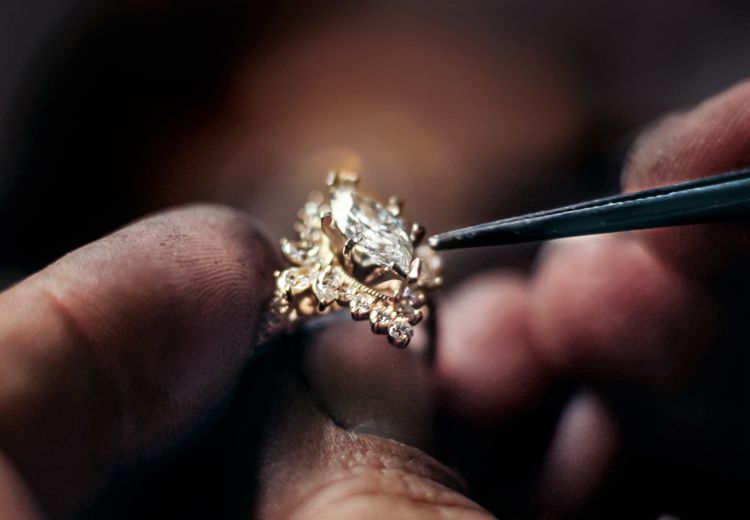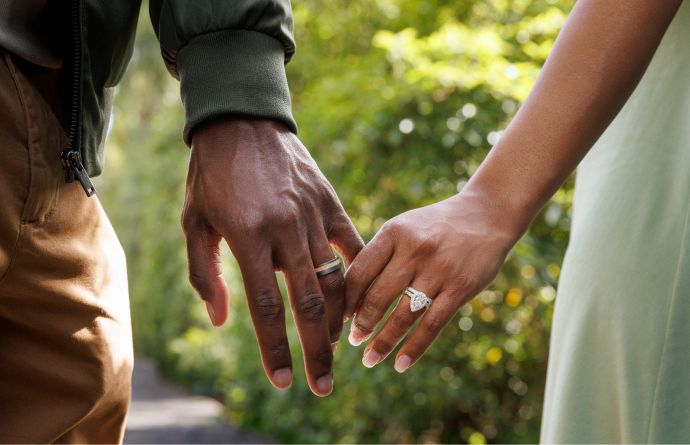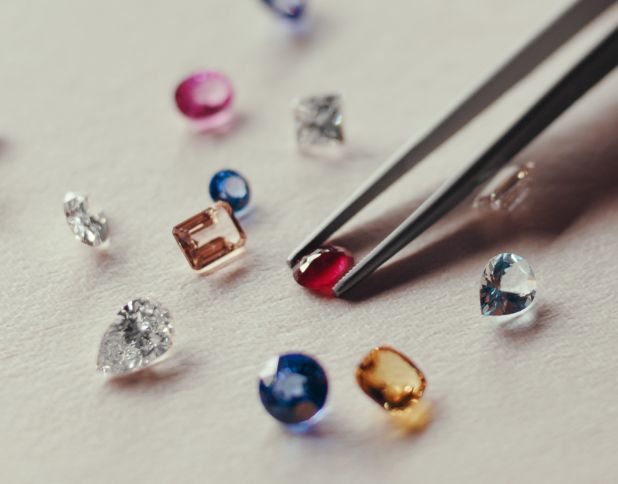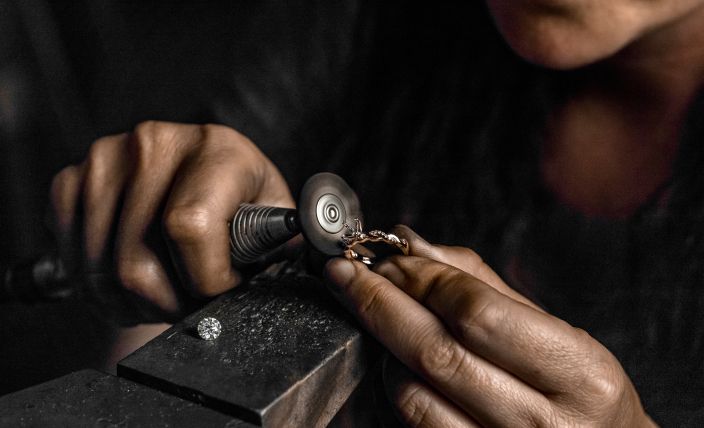Defining Diamond Terms
Defining Diamond Terms
Brillianteering
Brillianteering
When a jeweler is cutting a diamond into its final shape, the last step of this process is called brillianteering. Because it focuses on some of the major facets of the diamond, this step is incredibly important in determining the diamond’s quality and appearance.
When a jeweler is cutting a diamond into its final shape, the last step of this process is called brillianteering. Because it focuses on some of the major facets of the diamond, this step is incredibly important in determining the diamond’s quality and appearance.
Carat
Carat
The unit of weight used for diamonds and other gemstones.
The unit of weight used for diamonds and other gemstones.
Clarity
Clarity
In its simplest terms, diamond clarity is how “clear” a diamond appears. Any inclusions in the diamond or blemishes on its surface can affect the clarity of a diamond.
In its simplest terms, diamond clarity is how “clear” a diamond appears. Any inclusions in the diamond or blemishes on its surface can affect the clarity of a diamond.
Color
Color
Despite appearances, not all diamonds are completely translucent. The color of a diamond is an element of the 4Cs that refers to the diamond’s tint. A higher grade in color for a diamond means it is more “clear” looking, while a lower-graded stone may appear to have a yellowish tint
Despite appearances, not all diamonds are completely translucent. The color of a diamond is an element of the 4Cs that refers to the diamond’s tint. A higher grade in color for a diamond means it is more “clear” looking, while a lower-graded stone may appear to have a yellowish tint
Culet
Culet
The culet is the tiniest point at the very tip of the base of the diamond (also known as the pavilion). In most diamonds, the pavilion facets are expertly cut so that they meet at a perfect point, getting rid of the culet. When they do not meet at a point, the culet is counted as another facet of the diamond.
The culet is the tiniest point at the very tip of the base of the diamond (also known as the pavilion). In most diamonds, the pavilion facets are expertly cut so that they meet at a perfect point, getting rid of the culet. When they do not meet at a point, the culet is counted as another facet of the diamond.
Cut
Cut
The cut of a
diamond is the arrangement of the facets when polished and cut by the jeweler. Contrary to popular belief, it’s not the actual shape of the diamond, but rather the symmetry and proportions of its facets. A diamond that is cut better will appear more brilliant and sparkly than a poorly cut diamond.
The cut of a
diamond is the arrangement of the facets when polished and cut by the jeweler. Contrary to popular belief, it’s not the actual shape of the diamond, but rather the symmetry and proportions of its facets. A diamond that is cut better will appear more brilliant and sparkly than a poorly cut diamond.
Depth Percentage
Depth Percentage
The depth percentage of a
diamond is the diamond depth in relation to its width. A diamond with an ideal depth percentage will allow the light to hit each facet of the diamond at a precise angle, which allows for the highest amount of light being reflected through the top of the diamond. In other words, it creates the ultimate amount of sparkle!
The depth percentage of a
diamond is the diamond depth in relation to its width. A diamond with an ideal depth percentage will allow the light to hit each facet of the diamond at a precise angle, which allows for the highest amount of light being reflected through the top of the diamond. In other words, it creates the ultimate amount of sparkle!
Diamond Fluorescence
Diamond Fluorescence
About 25% to 35% of diamonds emit diamond fluorescence, which is the “glow” you may sometimes see appearing as a bluish or yellow/orange tint when the diamond is viewed under UV rays.
About 25% to 35% of diamonds emit diamond fluorescence, which is the “glow” you may sometimes see appearing as a bluish or yellow/orange tint when the diamond is viewed under UV rays.
Gemprint
Gemprint
A Gemprint uses patented technology to identify a unique “fingerprint” on any individual diamond. After being evaluated, the diamond’s Gemprint will be entered into a database so that any individual diamond can be identified from others, even if they look strikingly similar. This process can be used to identify lost or stolen diamonds.
A Gemprint uses patented technology to identify a unique “fingerprint” on any individual diamond. After being evaluated, the diamond’s Gemprint will be entered into a database so that any individual diamond can be identified from others, even if they look strikingly similar. This process can be used to identify lost or stolen diamonds.
Girdle
Girdle
The girdle of a diamond is the perimeter of the widest part of the diamond. This is the part of the diamond that usually makes contact with the setting itself. When measuring a diamond, the girdle is measured to determine the length and the width of the stone.
The girdle of a diamond is the perimeter of the widest part of the diamond. This is the part of the diamond that usually makes contact with the setting itself. When measuring a diamond, the girdle is measured to determine the length and the width of the stone.
Inclusion
Inclusion
A diamond inclusion is a flaw within the stone. They can appear as black marks, tiny holes, and small internal cracks. The lower the amount of inclusions in a diamond, the higher the clarity grade will be.
A diamond inclusion is a flaw within the stone. They can appear as black marks, tiny holes, and small internal cracks. The lower the amount of inclusions in a diamond, the higher the clarity grade will be.
Indented Natural
Indented Natural
The indented natural is a type of inclusion in a diamond where the surface of the rough diamond dips below the polished diamond’s surface, creating an indentation where the rough diamond cannot be polished.
The indented natural is a type of inclusion in a diamond where the surface of the rough diamond dips below the polished diamond’s surface, creating an indentation where the rough diamond cannot be polished.
Laser Drilling
Laser Drilling
The process of laser drilling is used to enhance a diamond’s overall clarity. A jeweler uses a laser to drill a tiny hole into the diamond in order to remove an inclusion, either with heat or by dissolving it with acid. While it can improve the clarity, treated diamonds can also end up being more fragile than non-laser-drilled stones, because the laser weakens the structure of the diamond.
The process of laser drilling is used to enhance a diamond’s overall clarity. A jeweler uses a laser to drill a tiny hole into the diamond in order to remove an inclusion, either with heat or by dissolving it with acid. While it can improve the clarity, treated diamonds can also end up being more fragile than non-laser-drilled stones, because the laser weakens the structure of the diamond.
Length to Width Ratio
Length to Width Ratio
The proportion of a diamond is also known as the length to width ratio. It’s calculated by dividing the length of a diamond by its width. Each type of diamond shape has a specific ratio range that is considered best for optimal light reflection.
The proportion of a diamond is also known as the length to width ratio. It’s calculated by dividing the length of a diamond by its width. Each type of diamond shape has a specific ratio range that is considered best for optimal light reflection.
Polish
Polish
The polish of a diamond refers to the finished appearance of a diamond after the jeweler “finishes” the stone by carefully polishing it to achieve a smooth, glossy look.
The polish of a diamond refers to the finished appearance of a diamond after the jeweler “finishes” the stone by carefully polishing it to achieve a smooth, glossy look.
Price Per Carat
Price Per Carat
When the price of a diamond is determined, it’s common to look at the price per carat. That means assigning a value to a carat weight, and then determining the overall price of the diamond based on how many carats it is.
When the price of a diamond is determined, it’s common to look at the price per carat. That means assigning a value to a carat weight, and then determining the overall price of the diamond based on how many carats it is.
Table Percentage
Table Percentage
The table percentage is calculated by dividing the size of the table (the largest facet of the diamond) by the diameter of the girdle. The table percentage can determine how the diamond disperses light, as well as the color dispersion. A table percentage that produces the most brilliant diamond will create a balance between the two.
The table percentage is calculated by dividing the size of the table (the largest facet of the diamond) by the diameter of the girdle. The table percentage can determine how the diamond disperses light, as well as the color dispersion. A table percentage that produces the most brilliant diamond will create a balance between the two.
Total Carat Weight
Total Carat Weight
While the diamond term “carat” simply refers to the unit of measurement used to weigh a diamond, “total carat weight” refers to the entire weight of all the diamonds used in a jewelry piece. For example, if you have an engagement ring with a 1-carat diamond in the center with eight .2-carat diamonds surrounding it, the total carat weight would be 2.6 carats.
While the diamond term “carat” simply refers to the unit of measurement used to weigh a diamond, “total carat weight” refers to the entire weight of all the diamonds used in a jewelry piece. For example, if you have an engagement ring with a 1-carat diamond in the center with eight .2-carat diamonds surrounding it, the total carat weight would be 2.6 carats.
Twinning Wisp
Twinning Wisp
A twinning wisp is a type of diamond inclusion where a collection of crystals, clouds, and/or pinpoints form inside the diamond, creating a look of distortion within the stone.
A twinning wisp is a type of diamond inclusion where a collection of crystals, clouds, and/or pinpoints form inside the diamond, creating a look of distortion within the stone.













